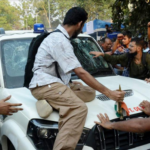In a momentous event that captured the hearts of thousands, Pope Francis arrived in the remote jungles of Papua New Guinea, bringing with him not just spiritual blessings but a substantial amount of humanitarian aid and toys for the local communities. The visit, marked by a vibrant display of local culture and profound expressions of faith, was a significant milestone in the pontiff’s global outreach efforts. The arrival of Pope Francis was met with an overwhelming response from the local population, who gathered in massive numbers to welcome him with traditional songs, dances, and a deep sense of reverence.
The Pope’s visit to Papua New Guinea, a country known for its rich cultural diversity and challenging geography, was more than just a diplomatic gesture; it was a heartfelt mission of compassion and solidarity. His presence in the remote regions of the country underscored his commitment to reaching out to the world’s most marginalized communities and addressing their needs with tangible support.
1. The Significance of the Papal Visit to Papua New Guinea
Papua New Guinea, an archipelago of over 800 islands in the southwestern Pacific Ocean, is renowned for its unique blend of cultures and languages, with more than 800 distinct languages spoken across the country. Despite its rich cultural heritage, many areas face significant challenges, including limited access to healthcare, education, and basic necessities. The visit of Pope Francis to this remote part of the world highlights the global Catholic Church’s commitment to addressing these issues and extending its support to underserved regions.
The visit also carries symbolic importance, reflecting the Pope’s emphasis on outreach to the peripheries of society. By traveling to Papua New Guinea, Pope Francis has demonstrated his dedication to meeting people where they are, regardless of their geographical or socio-economic conditions. This visit aligns with his broader mission of promoting social justice, peace, and humanitarian assistance.
2. Arrival and Warm Welcome
On the day of the Pope’s arrival, an estimated 20,000 people gathered on a vast field in front of the Vanimo Cathedral, located in the Sandaun Province of Papua New Guinea. The scene was one of extraordinary vibrancy and enthusiasm, with locals dressed in traditional attire, singing and dancing to welcome their esteemed guest. The air was filled with the sounds of indigenous music, and the colors of traditional costumes created a spectacular visual display.
As Pope Francis arrived, he was greeted with an outpouring of affection and respect. The local community presented him with a feathered headdress, a symbol of honor and reverence in their culture. In a gesture of mutual respect and cultural appreciation, Pope Francis donned the headdress, embracing the local customs and traditions with warmth and humility. This moment was a powerful symbol of the cross-cultural exchange that characterized his visit.
3. Humanitarian Aid and Toys: A Gesture of Compassion
One of the most impactful aspects of Pope Francis’ visit was the substantial humanitarian aid and toys that he brought with him. The Pope’s delegation had prepared a significant amount of aid, including medical supplies, food, and educational materials, to address the pressing needs of the local communities. This aid was a testament to the Pope’s commitment to alleviating suffering and improving the quality of life for those in need.
The toys, intended for children, were particularly symbolic. In many remote areas of Papua New Guinea, access to educational resources and recreational activities is limited. By bringing toys, Pope Francis aimed to bring joy and a sense of normalcy to the lives of young children, many of whom face daily hardships. The distribution of these toys was met with immense gratitude and happiness from the local families, who saw it as a gesture of kindness and solidarity.
4. The Impact of the Visit on Local Communities
The visit of Pope Francis had a profound impact on the local communities of Papua New Guinea. For many, it was a once-in-a-lifetime opportunity to witness the leader of the Catholic Church in person and to experience the sense of global connection that his visit represented. The Pope’s presence brought a sense of hope and encouragement to the local people, reinforcing the idea that they are not forgotten by the broader world.
In addition to the emotional and spiritual impact, the humanitarian aid provided by the Pope had tangible benefits for the communities. Medical supplies helped address immediate health needs, while educational materials supported local schools and educational programs. The toys brought joy to children and served as a reminder of the global community’s support for their well-being.
5. Papua New Guinea Cultural Exchange and Mutual Respect
Pope Francis’ visit to Papua New Guinea was also a celebration of cultural exchange and mutual respect. The Pope’s willingness to engage with local traditions and customs demonstrated his respect for the cultural heritage of the region. By participating in traditional ceremonies and wearing indigenous attire, Pope Francis showed that the Catholic Church values and honors the diverse cultures of the world.
The cultural exchange was not one-sided; it was a reciprocal process. The local communities embraced the Pope with open hearts and expressed their own cultural traditions through music, dance, and ceremonies. This exchange fostered a sense of mutual understanding and appreciation, highlighting the beauty of diversity and the importance of cultural inclusivity.
6. The Pope’s Message of Unity and Peace
Throughout his visit, Pope Francis conveyed a powerful message of unity, peace, and solidarity. His speeches and interactions emphasized the need for global cooperation in addressing the challenges faced by marginalized communities. The Pope’s message resonated with the local people, who saw his visit as a reaffirmation of their worth and dignity.
Pope Francis also addressed broader social issues, including the importance of protecting the environment, promoting social justice, and working towards sustainable development. His visit to Papua New Guinea highlighted the connection between global issues and local realities, urging both the international community and local leaders to work together for a better future.
7. The Broader Implications of the Visit
Pope Francis’ visit to Papua New Guinea has broader implications beyond the immediate impact on the local communities. It serves as a reminder of the Catholic Church’s global mission and its commitment to reaching out to the most underserved regions. The visit also underscores the importance of addressing global inequalities and promoting humanitarian efforts on a global scale.
For the Catholic Church, the visit reinforces its role as a global advocate for social justice and human dignity. It demonstrates the Church’s dedication to addressing the needs of the most vulnerable and promoting peace and solidarity across different cultures and communities.
For the people of Papua New Guinea, the visit represents a moment of recognition and connection with the global community. It brings attention to their unique challenges and highlights the need for continued support and development efforts in the region.
8. Conclusion
Pope Francis’ historic visit to Papua New Guinea was a remarkable event that combined spiritual significance with humanitarian outreach and cultural exchange. The Pope’s arrival was met with overwhelming enthusiasm and reverence from the local population, who welcomed him with traditional celebrations and a deep sense of gratitude.
The humanitarian aid and toys brought by the Pope had a significant impact on the local communities, addressing immediate needs and bringing joy to children. The visit also fostered a meaningful cultural exchange, showcasing the beauty of diversity and mutual respect.
Overall, Pope Francis’ visit to Papua New Guinea was a powerful demonstration of the Catholic Church’s commitment to global solidarity and social justice. It highlighted the importance of reaching out to marginalized communities, embracing cultural diversity, and working together for a more just and compassionate world. ALSO READ:- Lucknow Building Collapse: Three More Bodies Recovered, Toll Rises to Eight 2024





